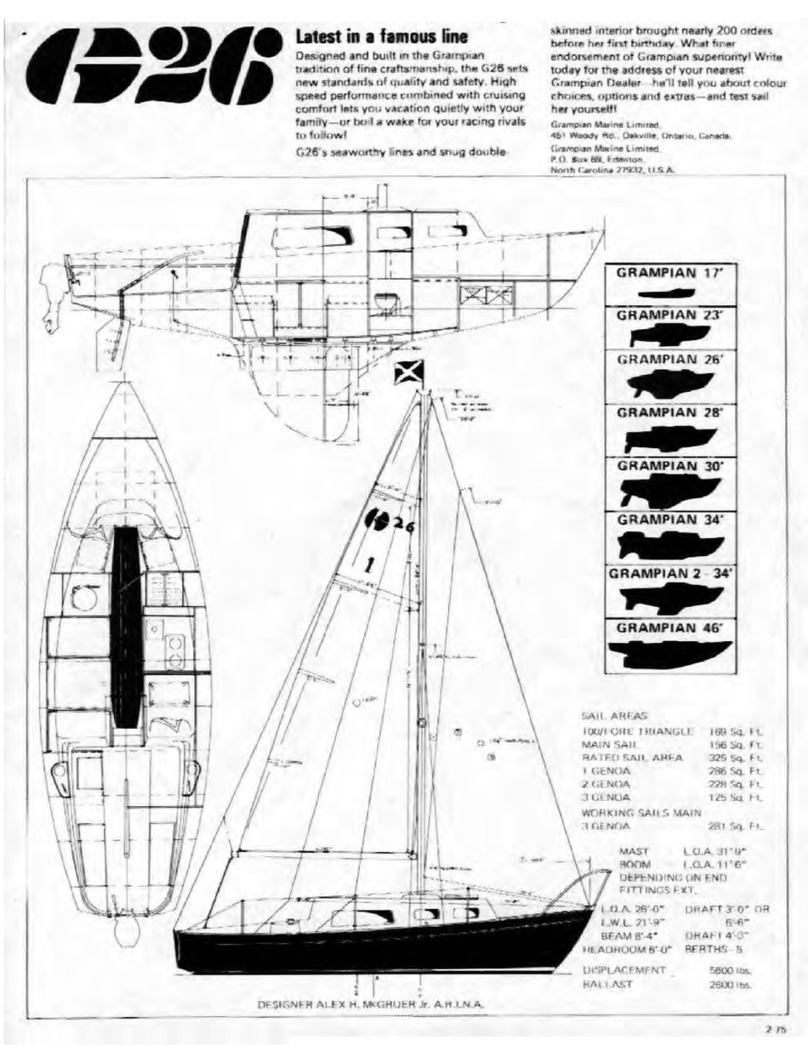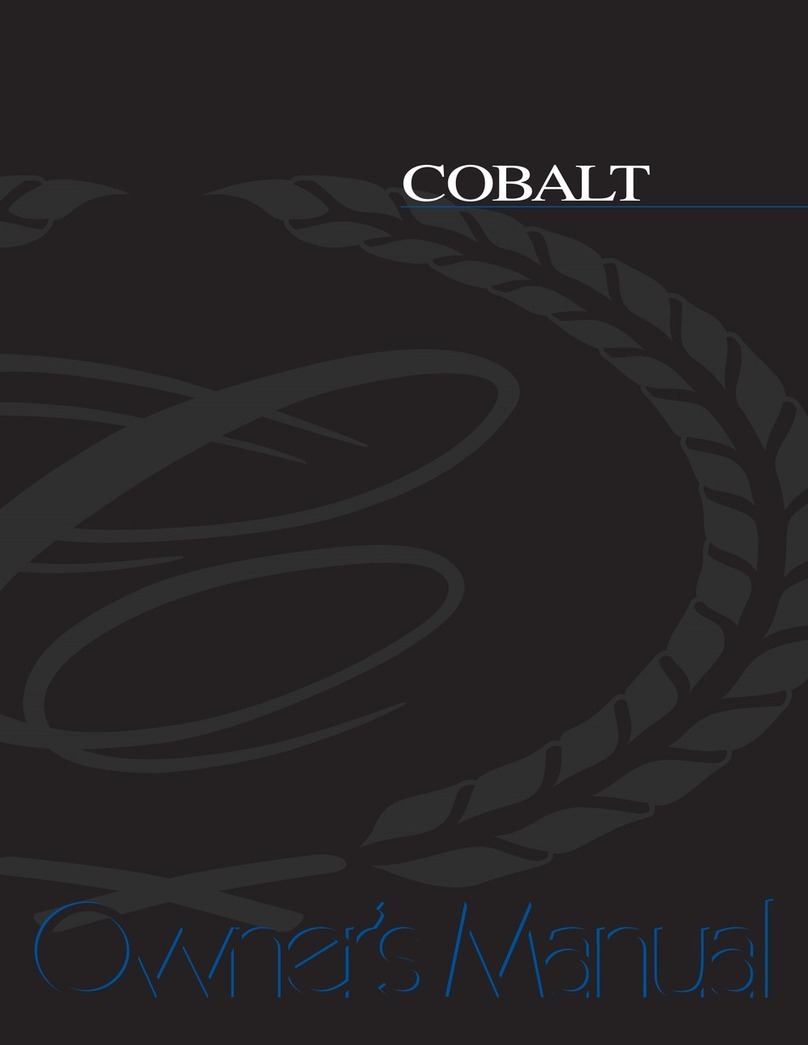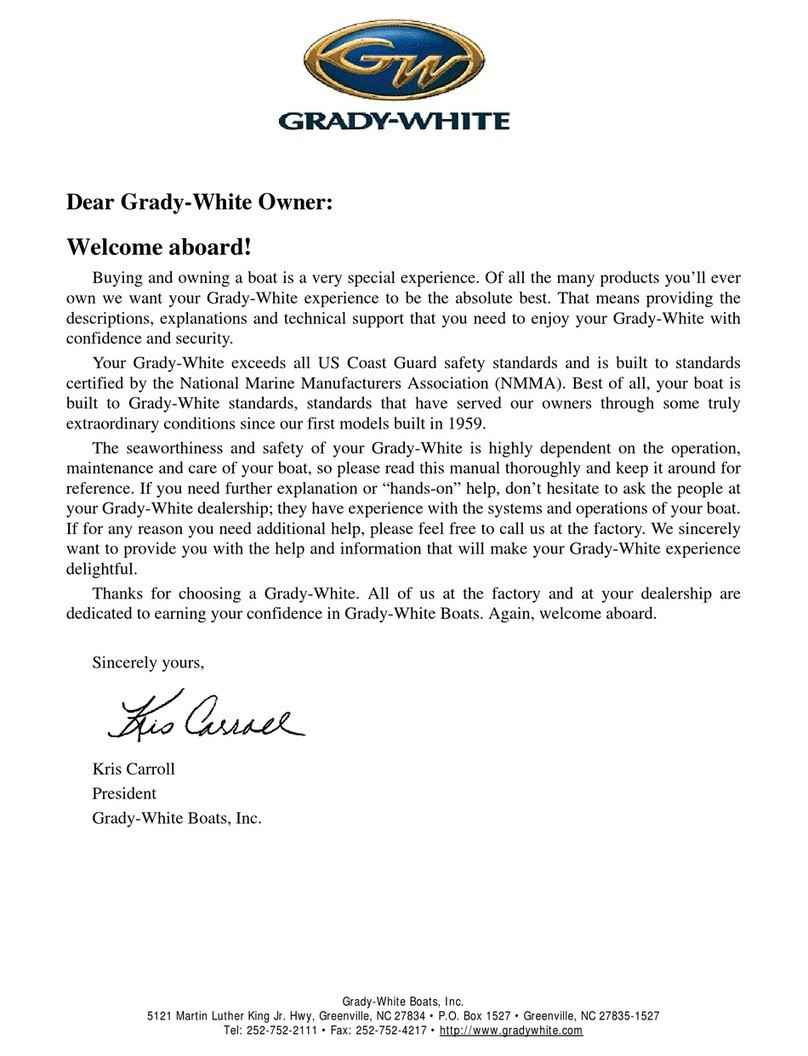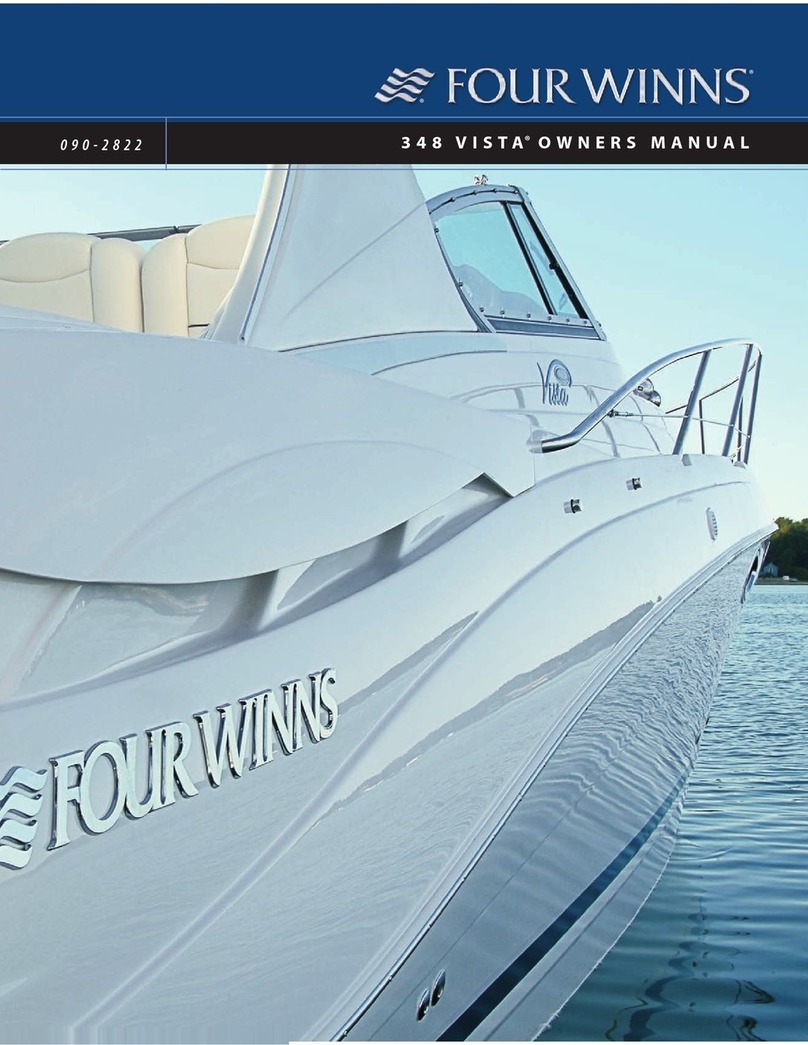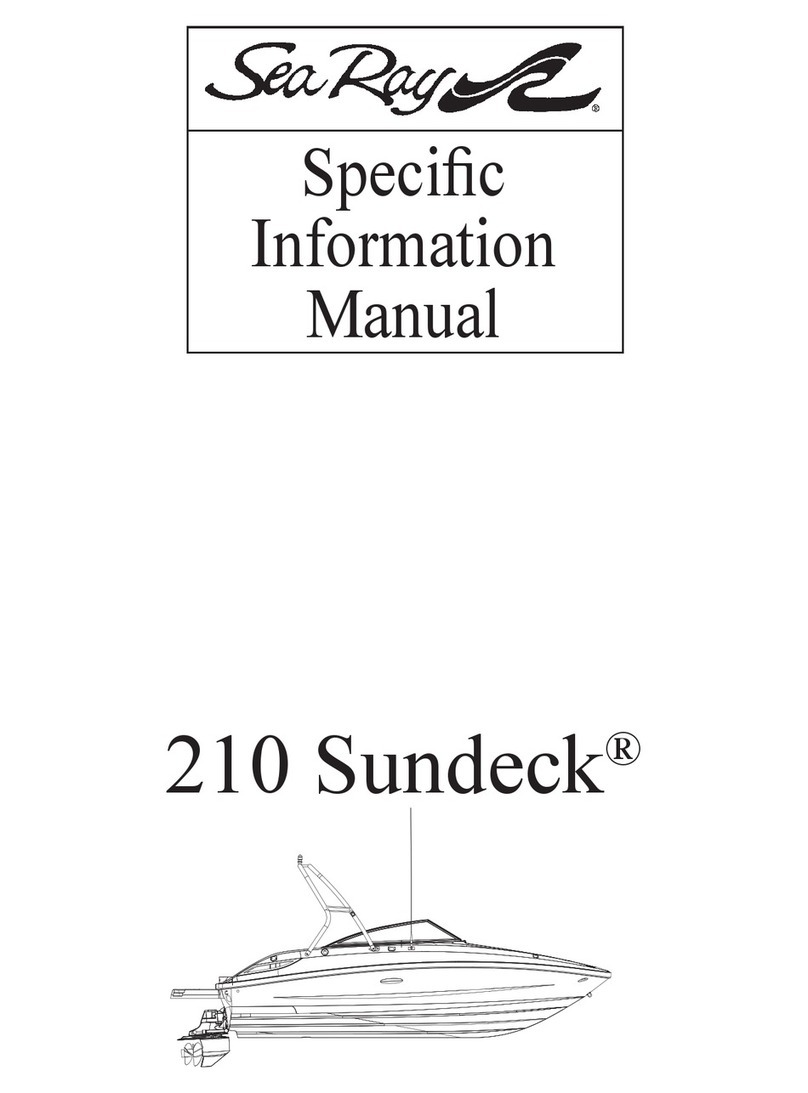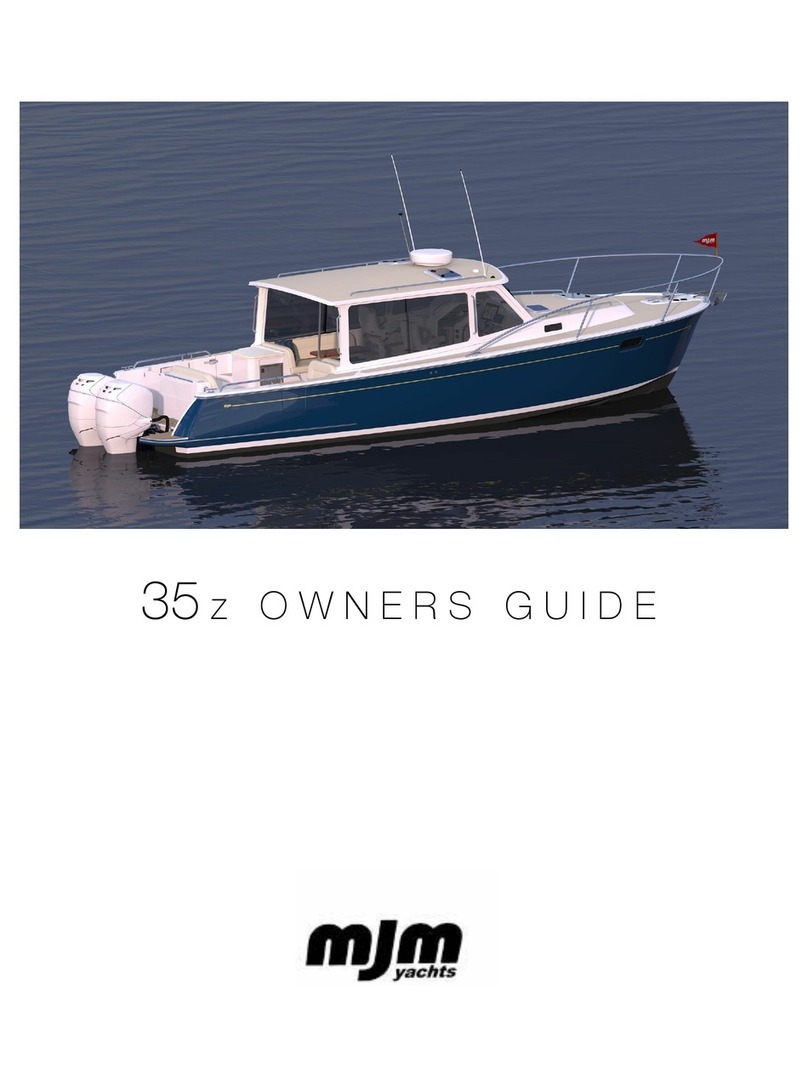GRAMPIAN 34 User manual

GRAMPIAN 34 OWNER’S MANUAL

Table of Contents
Introduction 1
Launching and Commissioning 2
Rigging 3
Winter Storage and Commissioning 6
Sails 7
Storing Sails 11
Electrical 12
Plumbing 15
Steering & Centerboards 18
Care of Interior & Exterior Wood 20
Care & Maintenance of Fiberglass 21
Windows - Cleaning & Maintenance 22
Tuning 23

1.
INTRODUCTION
The purpose of this manual is to acquaint owners with some of the features of
their Grampian sailboat and to offer assistance and advice concerning the
upkeep and maintenance of their boat.
While all boats in the Grampian line are extremely well equipped and are ready
for sailing, they may require minor adjustments at different times. This booklet
should be of assistance in making these adjustments.
This manual covers the plumbing and electrical systems, gelcoat maintenance
and repair, the upkeep of woodwork and the nature of rigging and sails. It also
endeavours to describe, in simple terms, the procedures to be followed in the
launching and rigging of a Grampian.
Although much of this information may be common knowledge, there are many
"tips" which should be useful to the experienced sailor and the newcomer alike.
We hope you enjoy reading about your Grampian, and if there is something you
need to know concerning your boat that the manual does not cover, please feel
free to give us a call, (416) 221-1419.

2.
LAUNCHING and COMMISSIONING
The following procedure is recommended for launching either for the first time or
after winter storage.
1. Lifting straps should be placed in front of and behind the keel. Care should be
taken to ensure that the straps are not twisted. When the tension is taken up by
the crane, is should be done slowly to ensure that the strays do not bear against
any sharp edges or rub against the lifelines stanchions or other non-structural
parts of the boat. These items can easily be bent twisted or broken by the
stresses generated during the launch
Warning: Under no circumstances should the straps be allowed to rest on the
propeller, shaft or bearing.
2. Attach long mooring lines to deck cleats at the bow and the stern. These can
be used to steady the boat when it is in the air and of course, secure it to the
dock when it is in the water. Fenders should also be attached to the side at the
boat which will be resting against the dock when it is lowered into the water.
3. Care should be taken to ensure that all sea cocks and gate valves are closed.
This will prevent leakage when the boat is launched and they can be opened
shortly thereafter to ensure: that all hose clamps and plumbing connections are
tight.
4. Launching is a good time to touch up those spots which were missed during
bottom painting, especially those spots which were covered by the cradle pads.
5. Lift and launch the boat. When it is in the water, unhook each lifting strap from
one side and carefully hold them away from the boat while the crane lifts them
out of the water. (Be careful not to unhook both sides the lifting straps or you may
have a number of fellow boaters somewhat annoyed with you.)
6. If you intend to move the boat away under its own power, either inboard or
outboard, check the owner’s manual and see engine section of this manual.
Ensure that the procedure for start-up and operation are followed thoroughly.
7. At this point you are ready to rig your boat

3.
RIGGING

4.
RIGGING
Each piece of the standing and running rigging is carefully marked and packed
for each new boat. The following is the procedure for rigging your Grampian.
1. Place the mast on trestles or wooden boxes.
2. Feed the jib halyard over the sheaves at the top at the mast on the
same side of the mast as the jib halyard winch, with the rope tail on
the aft side of the mast. This is usually the port side.
3. Feed main halyard over the sheave on the other side of the mast, this
time with the rope tail on the forward side of the mast (usually the
starboard side of the mast).
4. Topping lift - the purpose of the topping lift is to support the boom
when the sails are lowered. There are three types of topping lifts in
use for Grampians. See drawing for type used in your boat and attach
as shown in drawing.
5. Fix lower shrouds to their respective tangs. The Grampian 30 has four
lower tangs - two forward, two aft. All others models have two.
6. Attach the main shrouds to the tangs at the top and side of spar.
7. The forestay is attached to the toggle on the forward side of the mast
head fitting.
8. The back stay is attached to the aft toggle.
9. Remove the locking pins/split rings from the turnbuckles and remove
the clevis pins. Keep the locking pins and clevis pins handy to secure
the mast when it is lifted in place. The turnbuckles should be opened
halfway and should all turn in the same direction when they are being
tightened.
10. Attach the spreaders to the mast and put the main (upper) shrouds in
the grooves in the spreaders. Tape and cover the spreaders at the
mast and at their outboard ends. This will reduce chafing and possible
tearing of the sails. Note: Although more expensive, we recommend
rigging tape. It adheres to itself and can be removed easily without
leaving any trace.
11. If a Wind indicator is required, install at this time.
12. Attach the backstay to the chainplate at the back of the boat
13. If a crane is being to used to step the mast a large rope or strap
should be placed under the spreaders around the mast. A line should
be attached to the strap which can be used to pull it clear when the
mast is stepped.
14. Lift the mast into place and secure in place with standing rigging.
15. Attach forestay first and then secure upper shrouds. Lower shrouds
can be secured as soon as mast lifting strap has been removed.
16. When all clevis pins have been secured with locking pins/split rings,
tape around pins to eliminate the possibility of tearing or chafing of
sails.
17. Tighten rigging (see section on "Mast Tuning").
18. Attach boom and main sail.


3. Touch up or re paint bottom as necessary (see section on bottom
painting).
4. Carefully examine rigging, stuffing box and all mechanical gear for
wear and replace if necessary. Much of this can be done after the
boat goes in the water with the exception of the stuffing bar.
6.
WINTER STORAGE AND SPRING COMMISSIONING:
Preparing your Grampian for winter storage is perhaps more important than
spring commissioning. The more time spent cleaning and preparing the boat for
the winter storage, the less time required for commissioning in the spring. In
addition the boat will winter better and not age as quickly, it is recommended that
these procedures be followed for winter storage:
1. The Grampian should stand on its cradle or rest on blocks under its
keel and braced fore and aft.
2. The engine should be winterized according to the engine manual and
stored in a dry location, if it is an outboard
3. All moisture in the boat should be removed. It should be sponged out
of the bilge if necessary. This is especially important because
fibreglass will over time absorb any water with which it comes in
contact
4. Clean all interior fibreglass & dirt, grease and other foreign sub-
substances. This will help prevent the interior fibreglass from
becoming stained or marked.
5. Remove all batteries, re-charge and store in dry location.
6. Pump out and drain head and related plumbing.
7. Empty water tank and related plumbing.
8. Ensure that the boat is properly ventilated. Do not close all hatches
and restrict the circulation & air.
9. Cover the boat with a cover supported by a ridge pole. This can be a
frame system made of wood or PVC pipe and fittings or the mast. If
the mast is used, it must be supported and well covered in order to
prevent damage to the mast and to keep it dry.
10. Store the mast in dry place. Spreaders should be removed, but
standing and running rigging may be left attached to the mast.
In the Spring:
1. Clean deck and bull and thoroughly wax hull. The latter will help
prevent the ultra violet rays of the sun from chalking and discolouring
the hull.
2. Clean and oil all teak (see section on care of wood).

8.
SAILS
Foresails
To raise the foresail start with the tack which is attached to the bow casting by
means of a shackle (1/4" at 5/16"). The sail is then fastened to the foresail with
piston hanks. This process should begin with the hank closest to the tack. Ensure
that all hanks are facing the same direction and are not twisted. Attach jib halyard
to the head of the sail and the jib sheets to the clue. The latter is lead aft outside
f the stanchions and shrouds to the jib blocks on the toe-rail. It is recommended
that fig
them from blocks at the wrong time.
MainSail
oure of eight knots to tied in the ends of the jib sheet in order to prevent
accidentally slipping out of the
Hoisting th
and the foo
In most instances the luff is attached the main by either a bolt rope or plastic
slides.
The main i
boom. The at the gooseneck by inserting the tack
pin thro en attached
to the c and pulled tight and
cleated
Now it
doing this, by running your hands the full length
of the
eliminates
bolt rope
models wit y) there is a pin at the
bottom
pin is used sail is
raised or when it is lowered and stored on the boom. Now the battens should be
Battens
e main is a similar process to hoisting the jib except that both the luff
t of the sail are fixed into position by the mast and boom respectively.
The foot is attached to the main by means of a bolt rope.
s first attached to the boom and pulled fully out to the loose end of the
tack is attached to the boom
ugh the grommet of the sail and tightened. The outhaul is th
lew of the sail by means of the grommet at that end
.
is time to insert the luff at the main in the luff track on the mast. Before
ensure that the sail is not twisted
luff, starting with the tack, until you find the headboard. This process
the chance of the sail being hoisted with a twist. At this point insert the
or plastic slides in the luff track starting at the headboard. On the
h the plastic slides (which should be the majorit
of the luff track which has to be removed in order to insert the slides. The
to prevent the slides from falling out of the track before the
inserted.
Battens they support the
portion
would curl inward and the main would not function properly. It is important to trim
the luff
inserted wit
be taken to ensure that the battens are fully inserted in the batten pockets and
out. If the pockets are worn, it is often advisable to lightly sew the
ockets closed. Do not destroy the sail by over stitching.
With the battens inserted, the mainsail can now be raised. We recommend that
all sails be raised while you are heading into the wind starting with the main first.
The main sail should be hoisted to a point 6" below the top at the mast. This will
prevent chafing of the headboard against the backstay.
are a very important part of any mainsail because
of the sails leech which is called the roach. Without battens the roach
at the jib and the leech of the main for optimum performance. Battens are
h the thinner end in the deepest part of the batten pocket Care should
will not pop
p

9.
Topping Lift
ntioned earlier all Grampians come equipped with a topping lift. In
ddition to supporting the boom when the sail is down, the topping lift is used in
As was me
a
conjunction with the boom to support a boom tent. On the Grampian 20, 23 and
26 the topping lift is a short wire suspended from the backstay. On other models
it is a separate wire which extends from the mast.
Downhaul
The downhaul adjustment is made by attaching the downhaul line with a shackle
to an eye about 12 inches from the foot of the mast. This line is then run up to a
ingle block which should be attached to the gooseneck unit. The line is then
o a cleat opposite the eye where the line is made fast.
ension should be placed on the downhaul until the small wrinkles in the luff
s
lead back t
T
disappear. Downhaul tension can be used to adjust the position of the draft of the
sail. Additional tension will move the draft forward, while easing of tension will
move the draft aft. Generally the draft should be maintained about midpoint.
Outhaul
Outhaul tension is added until the small vertical lines in the foot of the sail
disappear. If additional flattening of the foot of the sail is required, tighten the
outhaul. Generally the foot is flattened more as the velocity of the wind increases.
Lowering the Sails
Sails should be lowered in the reverse order to the way in which they were
raised. Jib sails should be lowered and secured on the fore-deck by means of a
sail-tie. This will keep the sail on the deck until it can be safely and easily stored
below deck or on-shore. This sail should be lowered as the boat is headed into
the wind.
The mainsail should be lowered last and only after the engine has been started
and has been running for a few minutes. It is not critical to do this when there is
inimal wind, but it is a definite necessity when the wind is blowing and a good
t all times. It is especially a good idea when the boat is crewed by
experienced people.
member must assist by
y folds in it and the cloth
m
practise a
in
The mainsail can be lowered and allowed to rest on the boom. (Ensure that the
topping lift is attached before lowering the main.) One or two sail ties will secure
it to the boom until it can be properly folded and covered at the dock. The
mainsail can be flaked over the boom with the plastic slides left in the mast luff
track. Obviously this will speed up and facilitate the easy raising of the sails on
the next sailing day, but it is a practise which can wear out sails quicker.
It is recommended that the mainsail be rolled. This is achieved by starting at the
headboard and rolling along the luff of the sail. A crew
rolling the leech at the same time. In order to keep the sail flat and not bunched
up, pull the sail cloth between the leech and the luff every couple of turns.
Support the rolled main to the boom by loosely tied sail ties. By rolling the
mainsail the way a rug would be rolled, it will not have an

10.
and stitching will last longer. The jib can also be rolled and stored on a berth
elow with the jib sheets attached.
b
Important: Be certain to cover all sails left on deck, especially the mainsail. Sail
covers will block out the ultra-violet rays of the sun which are very harmful to sail
cloth and stitching.

11.
STORING SAILS FOR THE OFF-SEASON
e them carefully for the off-season. Sails should be checked,
leaned and then stored.
Sail Inspection
Sails should be inspected closely for chafe. You may find only minor wear, two or
three stitches gone, but these should be attended to during the off-season.
These items will spread and can cause unnecessary loss of sailing time during
the next season. The areas to examine carefully are the following:
- The area of the main which rubs the upper shrouds and spreaders.
- The leech of the main for rubbing by the backstay and topping lift.
- Both the inner and outer ends of the batten pockets.
- All grommet holes should be checked for distortion.
- All main sail slides and piston hanks on the jib. The latter should be given
one small drop of oil once a year.
- The foot of the jib, especially where it comes in contact with rigging,
lifelines and other parts of the boat.
Sail Cleaning
Cleaning all of your sails at least once a year will keep up their appearance and
increase their effective life span. Small sails can be cleaned in a bathtub. Larger
sails can be cleaned on a concrete surface. Both should be cleaned with a soft
scrub brush, using like warm water and a non-abrasive household detergent.
Sails should be thoroughly rinsed and allowed to dry spread out in the open air. If
you can hang them where they will not be whipped around, all the better Hang
them only from the head to the tack as they are hoisted on the boat.
Ironing is not recommended. This can cause localized fusing of the filaments and
distortion of the cloth. This can never be cured. The safest treatment for sails
which are badly creased is hosing them down with water and spread them out or
hang them as discussed. Sails may also be laundered in their bag using a
washing machine set at the permanent press setting. Alternatively, there are
companies who specialize in cleaning sails. You local sail maker has this service.
Storage
Sails should be completely dry before being stored for a long period of time in
order to prevent discolouration. They should be stored loosely in a dry area
where the air can circulate freely. It is important to avoid creases and ensure that
the area is dry. One of the best ways for storing sails is to roll them from the head
to the foot keeping the luff together. If possible, we recommend you roll the main
around the boom and hang the boom from the rafters.
Although sails today are made of synthetic fibres, you will get the best use of
your sails if you stor
c

12.
al system derives its power from a l2 volt battery. This
supplied to the lights and other accessories through a central switch panel and
ere is a master switch on the inboard models only. The negative
running lights
are w ered
thro h
The s e box.
ch panel on starboard side.
On a . The
bat y
me. T order to charge both
ust not
ELECTRICAL
Electrical System - D.C
.
The direct current electric
is
various fuses. Th
terminals ground to a grounding strip next to the fuse box. This in turn is
connected to the battery ground. The ground wire in all cases is black. This is an
internal 12 volt ground and cannot be used for a 110 volt AC system. The interior
lights are powered from the fuse panel by a blue positive wire. The
po ered from the fuse panel by a white positive wire. All extras are pow
ug the fuse panel by an orange positive wire.
e panel and grounding bar are located as follows:fu - G26 - on the bulkhead next to the ic
- G34, G2-34, G30 - in the engine compartment.
- G23 - inside the quarter berth.
- G28 - behind swit
bo ts with inboard engines, the batteries are charged by an alternator
ter switch can control the charging of one or both of the batteries at the same
he switch is generally left in the ALL position in
ti
batteries and m be left in the OFF while the engine is running. Damage to
ght result.
nce. lly
m.
the regulator mi
Shore Power
Shore power is an option on most boats. It is a beneficial option if you are
planning to do a lot of cruising and living aboard your boat. It can allow you to
have a lot more conveniences on your boat and run them without the concern of
running down the batteries.
If you have shore power there will be a second electrical panel in your boat. All
lights and extras, running lights excepted, will be wired to this panel. The wiring is
the same as in your home and trouble shooting is similar to trouble shooting
electrical problems at home. Caution and a circuit tester are your best tools. If
you have shore power, we recommend that you have the appropriate
attachments on board. Most marinas have the same universal receptacles which
ccept standard adapters, but some may not. This may cause you some
a
inconvenie
Caution - Always ensure that the shore power source is 110 volt, especia
when cruising abroad. 220 volt will damage the whole boat's electrical syste
Also ensure that the marina has a properly grounded system. Remember, your
boat is floating on water - one of the best electrical conductors.


14.
PLUMBING
The plumbing system for the Grampian is easy to understand. It can be traced
using the drawings in this manual. The system should be checked for leaks
periodically, and hose clamps should be checked especially where attached to
through-hull fittings.
Through-Hull Fittings
All through-hull fittings, except engine cooling water which has a sea cock, are
normally equipped with gate valves. These should be opened and closed at least
once a month to keep them in working order. Do not force the valves. They
should operate easily or they are corroded and need to be replaced. These
valves should be closed when not regularly in use.
Toilets
There are several different types of toilets installed. It is important that you read
the manufacturers instructions before using. The basic types of toilets are the
following:
1. Regular marine toilet with direct overboard flush. These types are
legal only in a few areas.
2. Regular marine toilet with direct overboard flush and holding tank.
These are legal in all areas provided that you are only using the
holding tank.
3. Recirculating chemical toilet which is self-contained.
4. Flush toilet with holding tank and pump-out fittings. Legal in all areas.
We recommend that the following hints be considered when using any of these
types of toilets:
1. It is always best to use the manufacturers suggested type of chemical
with a recirculating type. This will reduce the chance of the waste
exploding. It is not dangerous, but it is not a lot fun if it does explode.
2. Always flush out the holding tank and toilet unit with fresh water when
pumping out.
3. Do not leave waste sitting for a prolonged time. A weekly pump-out is
recommended.
Pressure Water
The pressure water system depends on the 12 volt system. The power must be
switched on for the system to recharge itself. Care should be taken to ensure that
adequate water is in the water tank at all times. Generally more water is used
with a pressure water system, than with a hand pump system.
Hand Pumps
Sometimes these units can become plugged. If this happens, remove the whole
pump from the sink and strip and clean. This will remove particles of foreign
matter from the ball system. Occasionally the pin that connects the pump handle
to the working parts inside has been known to slip, so the handle does not
engage the pump. In the event of this problem, remove the entire pump unit from
the sink, strip and position pin.

15
Ice Box
The ice box drains directly into the bilge by means of a hose. This hose can be
n stoves which have optional pressure tank for an alcohol stove, the following
filling the tank:
ssure.
6. Replace stopper and screw down tight.
plugged until you wish to drain it into the bilge or into a bottle or container for
easy disposal
Stoves.
O
must be observed when
1. All burners must be OFF
2. Main alcohol shut-off valve on the top of the pressure tank is closed
3. Tank pressure is zero.
4. Remove stopper.
5. Fill tank three quarters full to allow for air pre



18.
STEERING & CENTERBOARDS
Tiller Steering
Most Grampians are steered by means of a tiller connected to the top of the
rudder shaft by means of a fitting called a tiller head and fork. This fitting interacts
with the rudder shaft by means of a key. If the key is worn, then there will be play
between the rudder and the tiller. If there is play, replace the key and do not over
tighten the fitting. It can never be tightened to ensure there is no play. The tiller
head and fork will crack well before a tight fit occurs. If your tiller head and fork
does crack, Grampian Marine can replace it at a small cost. It is often a good
idea the remove your rudder and lubricate the shaft each spring. This will ensure
smoother operation of the rudder and less wear on the rudder shaft bearings.
Wheel Steering
Once installed wheel steering requires very little maintenance and only periodic
adjustment. Each year you should check the following:
1. The gland packing box. This sits on the rudder post tube. It is located
under the quadrant and should be checked about once per month for
seepage. It can be tightened by the three bolts at the top of the unit.
(Some models - 1974 and prior - do not have the gland packing box.)
2. The cable should be checked for play and tightened if necessary. The
adjustment is located on the quadrant.
3. All sheaves are self-lubricating and do not need attention.
4. The emergency tiller is necessary with all wheel steering units. It attaches
to the top of the rudder post which is behind the steering pedestal. On
most boats a small plate or cover is on the cockpit sole over the top of the
rudder post top.
Centerboards (see diagram)
The centerboard assembly is the same for all Grampians - 23, 26, 30. The
system should be checked at least once a year for fraying cables and other
potential problems. Where electrolytic action is greater, the need for frequent
inspection is greater.
It is also important to ensure that the boards are kept free of foreign matter.
Regular cleaning and proper spring maintenance are essential for smooth
operation of the Center board.
If the board cannot be raised, a weighted rope slung under the bow and walked
aft can snag the board and hold it in a raised position until repairs can be made.
If the board cannot be lowered, then the board is most likely fouled. The boat will
have to be removed from the water and the mechanism removed and both the
board and the keel housing thoroughly cleaned.

Table of contents
Other GRAMPIAN Boat manuals
Popular Boat manuals by other brands
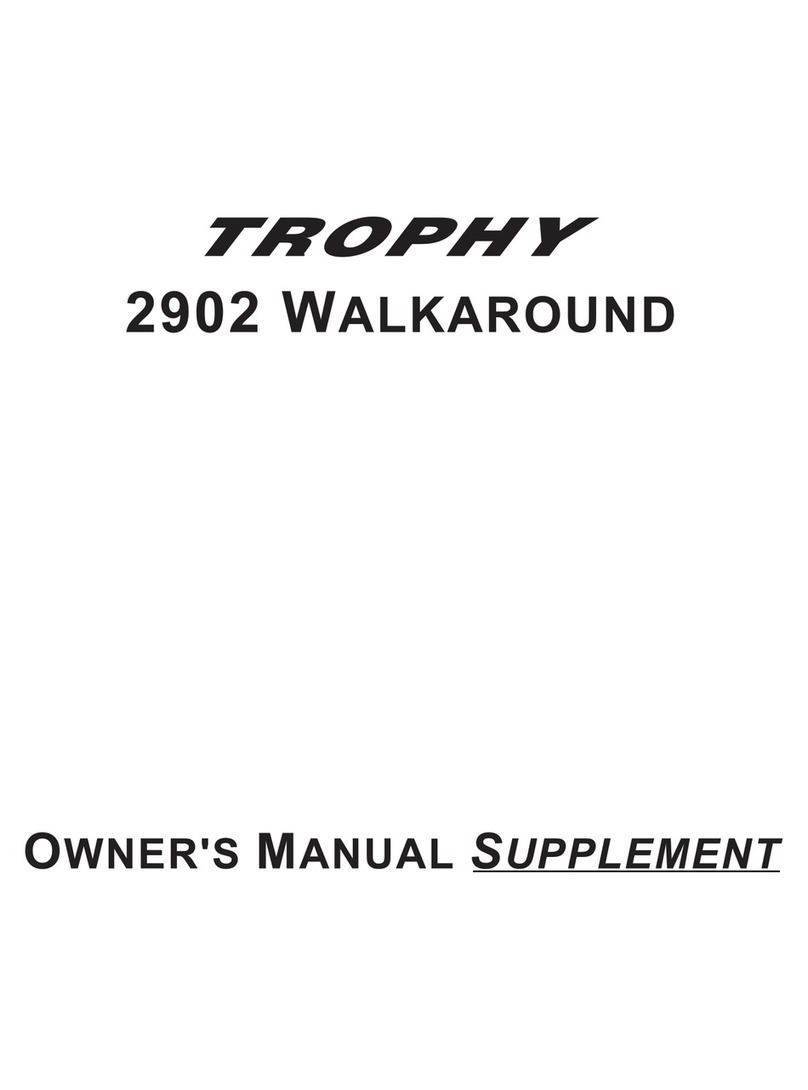
Trophy
Trophy 2909 Walkaround owner's manual

Scout Boats
Scout Boats 300 LXF owner's manual
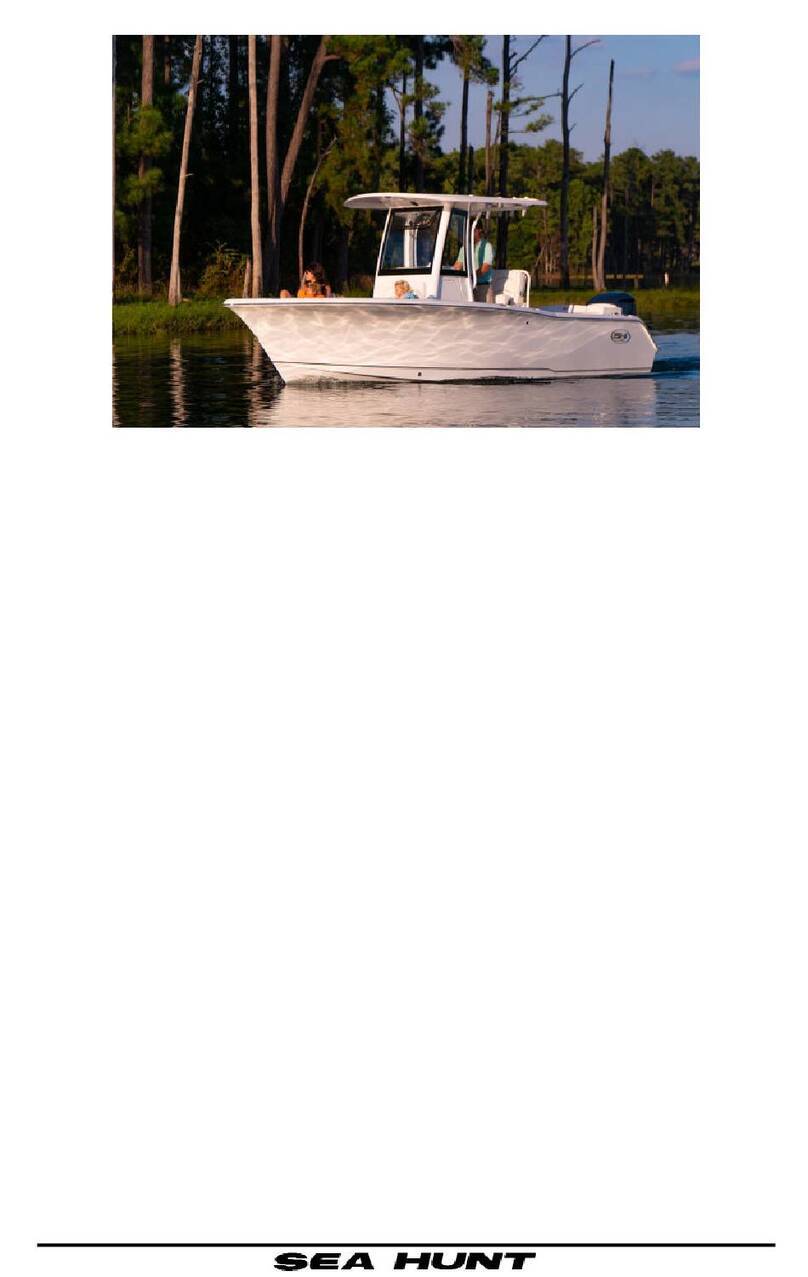
Sea Hunt
Sea Hunt Triton Series manual
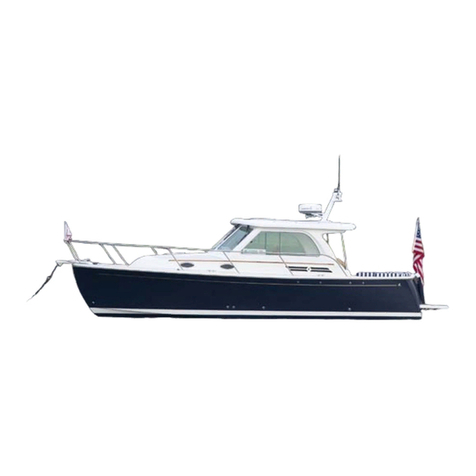
Back Cove Yachts
Back Cove Yachts Back Cove 30 owner's manual
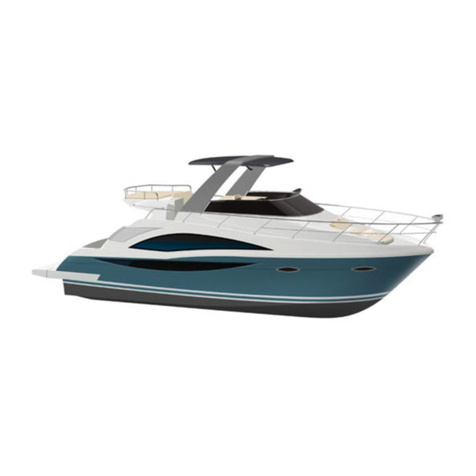
Carver Yachts
Carver Yachts 44 Sojourn Setup Procedures
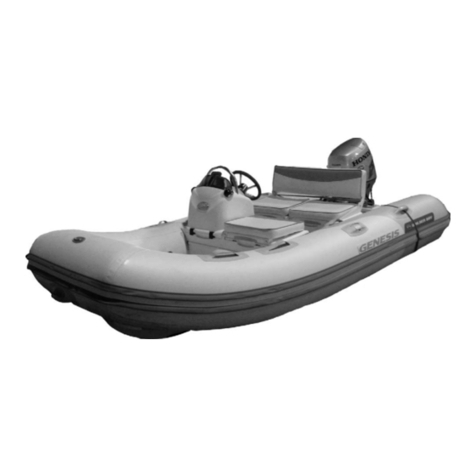
Walker Bay
Walker Bay Genesis Console 310 Assembling instructions
